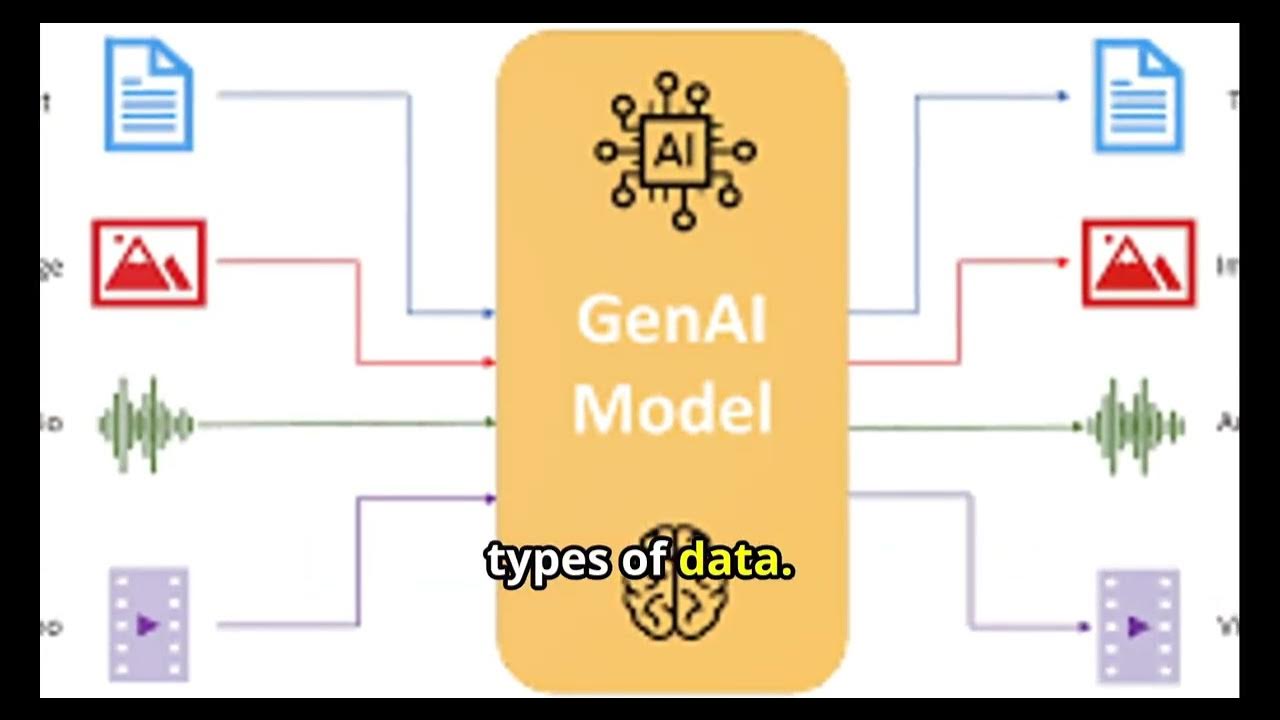Generative AI Explained In 5 Minutes | What Is GenAI? | Introduction To Generative AI | Simplilearn
Summary
TLDRThis video introduces Emma, a graphic designer who explores generative AI, a technology that creates unique content like images, text, music, and more. The video explains how generative AI works, using large data sets and advanced algorithms to generate original outputs based on user prompts. It covers the process of training AI models, including the use of neural networks, feedback mechanisms, and reinforcement learning to enhance accuracy. The video also touches on the applications of generative AI in content creation, art, music, and healthcare, and concludes with an interactive quiz to engage viewers.
Takeaways
- 😀 Generative AI creates new content like text, images, music, and videos by learning from vast data sets.
- 😀 Unlike traditional AI, which categorizes data, generative AI produces unique, original material based on patterns it learns.
- 😀 Tools like GPT-4 and DALL·E use AI to create art, write essays, or simulate conversations through user prompts.
- 😀 Generative AI has applications in content creation, music, audio, healthcare, and design, among others.
- 😀 For image generation, AI is trained on large data sets of images paired with text descriptions to recognize objects, styles, and associations.
- 😀 AI models like DALL·E process prompts using transformer models to link words to images and create coherent visuals.
- 😀 Text input is split into smaller units called tokens, which the AI processes to understand relationships and generate accurate images.
- 😀 Feedback from users helps AI improve; if the generated image is inaccurate, users can mark it, allowing the AI to refine its output.
- 😀 Reinforcement learning helps AI models improve by rewarding accurate results and correcting mistakes, improving over time.
- 😀 Data scientists curate the training data, defining parameters that guide the AI’s processing and generation of outputs.
- 😀 Once trained, the AI generates original creations, such as a futuristic cityscape, demonstrating its ability to combine learned patterns with creativity.
Q & A
What is generative AI?
-Generative AI is a type of artificial intelligence designed to create new content, such as text, images, music, and videos, rather than analyzing or categorizing existing data.
How does generative AI differ from traditional AI?
-Traditional AI analyzes or categorizes data, while generative AI creates new, original content based on patterns learned from large datasets.
What are some applications of generative AI?
-Generative AI can be used in content creation, such as generating text for blog posts or stories, creating custom images and designs, composing music, and even simulating disease progression in healthcare.
How does the training process of generative AI work?
-Generative AI is trained on large datasets of text, images, or other content. It learns to recognize relationships between these elements, and uses neural networks and transformers to generate new content based on user prompts.
What is a transformer model in generative AI?
-A transformer model is a type of neural network that processes input text, recognizing patterns and relationships between words. It helps the AI combine elements into a coherent output, such as generating images based on text descriptions.
What are tokens in generative AI?
-Tokens are smaller parts into which the input text is split. The AI processes these tokens to understand the relationships and context, such as placing sunglasses on a cat in an image.
How does feedback improve generative AI?
-Users provide feedback on generated content, such as images. If the output is incorrect, like sunglasses floating beside a cat, the AI learns from the feedback and improves its future generation abilities.
What is reinforcement learning in generative AI?
-Reinforcement learning is a method where the AI is rewarded for generating accurate content and corrected when mistakes occur. Over time, this process helps the AI improve its output generation.
Why is diverse training data important for generative AI?
-Diverse training data helps the AI learn a wide range of patterns, making it more versatile in generating various types of content. The more varied the dataset, the better the AI can produce accurate and diverse outputs.
Can generative AI create completely original content?
-Yes, once trained, generative AI can produce entirely original content. For instance, it can generate unique images based on descriptions, combining learned patterns and creativity rather than simply replicating existing data.
Outlines

Cette section est réservée aux utilisateurs payants. Améliorez votre compte pour accéder à cette section.
Améliorer maintenantMindmap

Cette section est réservée aux utilisateurs payants. Améliorez votre compte pour accéder à cette section.
Améliorer maintenantKeywords

Cette section est réservée aux utilisateurs payants. Améliorez votre compte pour accéder à cette section.
Améliorer maintenantHighlights

Cette section est réservée aux utilisateurs payants. Améliorez votre compte pour accéder à cette section.
Améliorer maintenantTranscripts

Cette section est réservée aux utilisateurs payants. Améliorez votre compte pour accéder à cette section.
Améliorer maintenantVoir Plus de Vidéos Connexes

Intro to Generative AI for Busy People

Generative AI for Absolute Beginners : Types of Generative AI

What is Generative AI | Introduction to Generative AI | Generative AI Explained | Simplilearn

CoPilot untuk Membuat Konten

Generative AI for Absolute Beginners : Introduction

Apa Itu Generative AI? Pahami dalam 2 Menit!
5.0 / 5 (0 votes)
